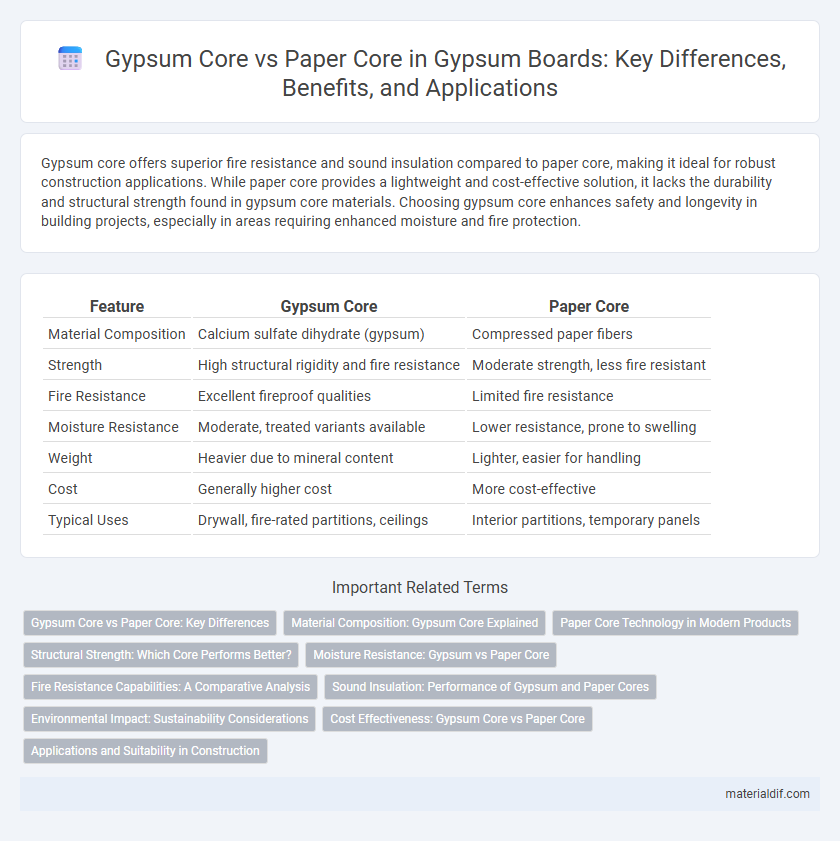Gypsum core offers superior fire resistance and sound insulation compared to paper core, making it ideal for robust construction applications. While paper core provides a lightweight and cost-effective solution, it lacks the durability and structural strength found in gypsum core materials. Choosing gypsum core enhances safety and longevity in building projects, especially in areas requiring enhanced moisture and fire protection.
Table of Comparison
| Feature | Gypsum Core | Paper Core |
|---|---|---|
| Material Composition | Calcium sulfate dihydrate (gypsum) | Compressed paper fibers |
| Strength | High structural rigidity and fire resistance | Moderate strength, less fire resistant |
| Fire Resistance | Excellent fireproof qualities | Limited fire resistance |
| Moisture Resistance | Moderate, treated variants available | Lower resistance, prone to swelling |
| Weight | Heavier due to mineral content | Lighter, easier for handling |
| Cost | Generally higher cost | More cost-effective |
| Typical Uses | Drywall, fire-rated partitions, ceilings | Interior partitions, temporary panels |
Gypsum Core vs Paper Core: Key Differences
Gypsum core offers superior fire resistance and soundproofing compared to paper core, making it ideal for construction and drywall applications. Unlike paper cores, gypsum cores provide enhanced structural stability due to their mineral composition, resulting in increased durability and moisture resistance. These key differences highlight gypsum core as a preferred choice for building materials requiring strength and safety performance.
Material Composition: Gypsum Core Explained
Gypsum core is primarily composed of natural gypsum plaster, which is a calcium sulfate dihydrate, offering excellent fire resistance and soundproofing qualities. In contrast, paper cores consist of layers of cellulose fibers bonded together, providing less durability and reduced moisture resistance compared to the mineral-based gypsum core. The inorganic nature of gypsum core enhances structural stability and mold resistance, making it a preferred choice for drywall applications.
Paper Core Technology in Modern Products
Paper core technology in modern gypsum products enhances strength and flexibility by integrating recycled cellulose fibers, improving structural integrity compared to traditional gypsum cores. This innovative approach reduces environmental impact through sustainable sourcing while maintaining fire resistance and moisture control in drywall applications. Advanced paper cores also enable lighter panels, facilitating easier installation and improved handling without compromising durability.
Structural Strength: Which Core Performs Better?
Gypsum core demonstrates superior structural strength compared to paper core due to its dense composite makeup, providing enhanced resistance to impact and sagging. Its inherent fire-resistant properties contribute to maintaining structural integrity under high temperatures, making it ideal for load-bearing applications. In contrast, paper core tends to be less durable and more susceptible to moisture damage, reducing its overall strength in structural environments.
Moisture Resistance: Gypsum vs Paper Core
Gypsum core drywall offers superior moisture resistance compared to paper core drywall due to its non-organic mineral composition that does not absorb water, reducing the risk of mold and structural damage. Paper core drywall contains an organic cellulose-based paper layer that can retain moisture, leading to swelling, warping, and mold growth over time. This makes gypsum core drywall the preferred choice in high-humidity environments such as bathrooms and basements.
Fire Resistance Capabilities: A Comparative Analysis
Gypsum core drywall exhibits superior fire resistance compared to paper core alternatives due to its non-combustible mineral composition, which effectively slows heat transfer and prevents flame penetration. The dense gypsum core contains chemically bound water that releases steam when exposed to fire, enhancing its fire-resistant properties by cooling and acting as a heat barrier. In contrast, paper core materials lack this inherent thermal protection, making gypsum core systems the preferred choice in fire-rated wall assemblies for enhanced safety and compliance with building codes.
Sound Insulation: Performance of Gypsum and Paper Cores
Gypsum cores provide superior sound insulation due to their dense, non-porous composition, effectively dampening airborne noise and reducing sound transmission between rooms. In contrast, paper cores offer less acoustic performance because their fibrous structure allows more sound to pass through. Gypsum core panels are commonly preferred in construction projects that require enhanced acoustic privacy and compliance with noise control standards.
Environmental Impact: Sustainability Considerations
Gypsum core boards offer a more sustainable alternative to paper core boards due to their higher recyclability and lower carbon footprint during production. Gypsum materials are composed of abundant natural minerals, reducing reliance on deforestation unlike paper cores, which depend on wood pulp. Lifecycle analysis highlights gypsum core's reduced environmental impact through energy-efficient manufacturing and enhanced durability, promoting longer service life and less frequent replacement.
Cost Effectiveness: Gypsum Core vs Paper Core
Gypsum core drywall offers superior cost effectiveness compared to paper core due to its enhanced durability and fire resistance, reducing long-term maintenance and replacement expenses. The denser gypsum core minimizes damage from impacts and moisture, leading to lower repair costs and extended lifecycle performance. While paper core panels may have a lower upfront cost, gypsum cores provide better value by minimizing overall project expenses through improved resilience and safety compliance.
Applications and Suitability in Construction
Gypsum core drywall offers superior fire resistance and sound insulation, making it ideal for residential and commercial interior walls and ceilings. Paper core drywall, often lighter and more flexible, is suitable for non-load-bearing partitions and areas with lower moisture exposure. Gypsum core's moisture-resistant variants enhance suitability for bathrooms and kitchens, whereas paper core is best reserved for dry, low-impact environments.
Gypsum core vs Paper core Infographic

 materialdif.com
materialdif.com